In recent years, the culinary landscape has witnessed a fascinating transformation, with innovative appliances like the industrial panini press becoming a staple in both European and American kitchens. This shift has been driven by a confluence of factors, from changing consumer habits to technological advancements. As we delve into the intricacies of the market dynamics and the impact of health and wellness trends, it becomes clear that the future of industrial panini presses is not just a matter of technological evolution, but also a reflection of broader societal changes.
TheEvolutionofPaniniPresses
The evolution of panini presses has been a fascinating journey, transforming from simple household gadgets to robust commercial appliances. Initially, panini presses were introduced as a novelty item for home chefs and enthusiasts looking to replicate the Italian street food experience in their own kitchens. These early models were often compact, with single plates that required careful handling to achieve the perfect press and grill marks.
Over time, as the popularity of panini sandwiches grew, manufacturers began to refine the design. The introduction of double-plate systems allowed for more even cooking and easier operation, as the top plate could be pressed down smoothly with minimal effort. This innovation marked the beginning of the panini press’s transition from a niche appliance to a staple in many households.
As technology advanced, so did the capabilities of panini presses. The introduction of adjustable heat settings and non-stick surfaces made these devices more versatile and user-friendly. Consumers could now tailor the cooking temperature to their preferences and enjoy a variety of sandwich options without worrying about food sticking to the plates.
In the commercial sector, the demand for efficient and consistent sandwich-making equipment led to the development of industrial panini presses. These units were designed to handle high volumes of food quickly and with precision. They featured larger plates, powerful motors, and sometimes even conveyor belts to streamline the production process. The commercial panini press was no longer just a tool for creating sandwiches; it was a key component in fast-casual and full-service restaurants.
The rise of gourmet and artisanal food culture further propelled the evolution of panini presses. High-end models with intricate designs and premium materials began to appear, catering to chefs and restaurant owners who wanted to offer a unique dining experience. These professional-grade presses often included advanced features like adjustable pressure, variable temperature control, and even the ability to customize the cooking surface to mimic the look and feel of traditional wood or stone.
The impact of international cuisine on the panini press market cannot be overstated. As the world became more interconnected, so did the flavors. Chefs around the globe started experimenting with different ingredients and cooking techniques, leading to a surge in demand for panini presses that could handle a wide range of foods. This included not just sandwiches, but also wraps, flatbreads, and even pizza.
Environmental concerns also played a role in the evolution of panini presses. As sustainability became a key issue in the foodservice industry, manufacturers started to produce presses that were more energy-efficient and easier to maintain. Features like automatic shut-off and programmable cooking cycles helped reduce energy consumption and extend the lifespan of the appliances.
The digital age brought about another wave of innovation. Smart panini presses with digital interfaces and connectivity options allowed for precise control over cooking parameters. These appliances could be integrated into restaurant management systems, providing data on usage patterns and maintenance needs.
In summary, the evolution of panini presses has been driven by a combination of consumer demand, technological advancements, and the influence of global culinary trends. From the simple, single-plate models of the past to the sophisticated, multi-functional industrial presses of today, the panini press has become an indispensable tool in both home and commercial kitchens. Its journey reflects the ever-changing landscape of food preparation and the quest for convenience, quality, and innovation.
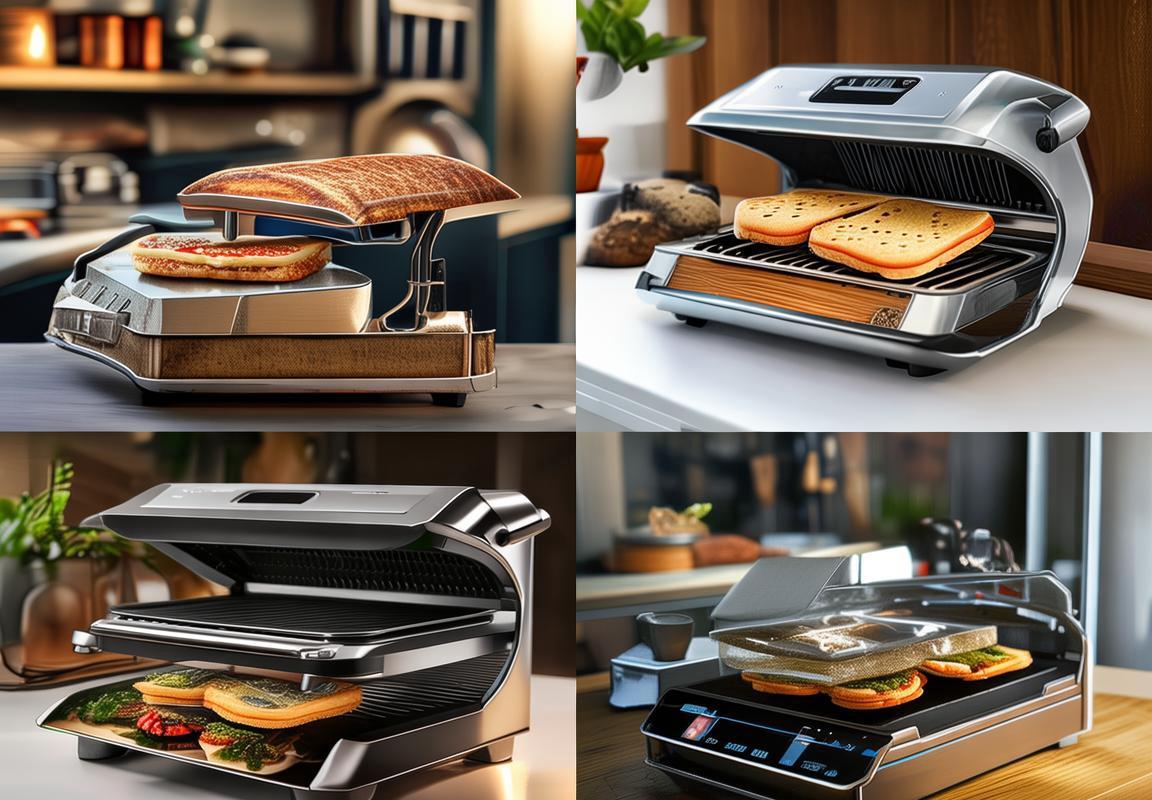
MarketDynamicsinEurope
The European market for panini presses has seen a fascinating evolution, shaped by a blend of culinary trends, consumer demands, and technological advancements. From humble origins in Italian homes to a staple in various European cafes and restaurants, the journey of the panini press has been marked by several key dynamics.
In the early days, panini presses were a rarity, confined to the Italian kitchens where they were cherished for their ability to create the iconic, pressed sandwiches. As the concept of the panini spread, so did the devices that made it possible. The European market, with its diverse culinary landscapes, began to embrace the panini press as a versatile tool for creating a variety of pressed sandwiches, not just the traditional Italian versions.
The rise of the fast-casual dining trend has been a significant driver in the market’s growth. With consumers seeking convenience without compromising on taste, panini presses became a hit in cafes, delis, and quick-service restaurants. The ease of use and the ability to quickly cook a variety of ingredients at once made these appliances a must-have for busy establishments.
Health consciousness has also played a pivotal role in shaping the market dynamics. As more Europeans adopt a healthier lifestyle, there has been a surge in demand for sandwiches that are not only delicious but also packed with fresh ingredients and nutritional value. This has led to a proliferation of panini presses that offer features like adjustable heat settings and non-stick surfaces, making it easier for chefs to create healthier options.
The European market is also influenced by the cultural diversity within its borders. Countries like France, Germany, and the UK have their own versions of pressed sandwiches, which have been adapted to work with the panini press. For instance, the French have embraced the panini press for its ability to make croque monsieur and croque madame, while in the UK, it’s been used to craft variations of the classic bacon butty.
Another important factor is the growing trend of gourmet dining, where the panini press has become a tool for chefs to experiment with flavors and textures. The ability to sear ingredients and achieve a perfect golden-brown crust has made the panini press a favorite among culinary professionals looking to add a touch of sophistication to their menus.
The panini press has also been a victim of its own success, with a plethora of models and brands available on the market. This has led to a fierce competition among manufacturers, each trying to innovate and offer something unique. Features such as variable temperature controls, digital displays, and automatic shut-off functions have become standard, with some brands even offering programmable settings for specific types of sandwiches.
The European market has also seen a shift towards sustainability, with consumers and businesses alike becoming more environmentally conscious. This has influenced the design and manufacturing of panini presses, with an increasing number of models made from eco-friendly materials and with energy-saving capabilities.
In recent years, the integration of panini presses into home kitchens has also gained momentum. As people look for ways to recreate the flavors of their favorite restaurants at home, the convenience and versatility of these appliances have made them a popular choice among home cooks.
The market dynamics in Europe continue to evolve as technology advances and consumer preferences change. The panini press, once a simple kitchen gadget, has now become a symbol of culinary innovation, convenience, and health, solidifying its place as a staple in the European kitchen.

TheAmericanPaniniPressPhenomenon
The American Panini Press Phenomenon has been a fascinating development in the culinary world, transforming the way we think about grilled sandwiches. From humble beginnings in Italian restaurants to becoming a staple in both fast-casual and fine dining establishments, the journey of the Panini press in the U.S. is marked by a blend of innovation, convenience, and a growing appreciation for gourmet sandwiches.
In the early days, the Panini press was a niche item, primarily found in Italian eateries where it was used to prepare authentic Italian sandwiches. However, as American palates diversified, the press started to gain traction among food enthusiasts who were looking for a quick and delicious way to enjoy a hot, toasted sandwich. The compact and efficient design of the Panini press made it an appealing option for busy individuals who wanted a gourmet treat without the wait.
The rise of the Panini press in the American market was also fueled by the growing popularity of fast-casual dining. Chains like Panera Bread and Chipotle began incorporating the press into their menu, offering customers a variety of sandwiches that were both satisfying and portable. The convenience of the Panini press, with its ability to cook multiple sandwiches at once, became a hit with customers who were accustomed to the efficiency of fast-casual service.
As the years went by, the Panini press evolved from a simple tool for making sandwiches to a versatile appliance that could be used to cook a wide range of dishes. Chefs and culinary innovators started experimenting with the press, using it to grill vegetables, meats, and even desserts. The press’s even heat distribution and ability to lock in flavors made it a favorite among those looking to elevate their culinary creations.
The American Panini Press Phenomenon also saw the rise of the “Build-Your-Own” sandwich concept. Customers could now customize their sandwiches with a variety of fillings, from classic Italian meats and cheeses to exotic ingredients like Korean kimchi or avocado. This personalization trend not only added to the appeal of the Panini press but also contributed to the growth of gourmet sandwich shops and food trucks across the nation.
Moreover, the Panini press became a symbol of convenience and health. With the increasing awareness of health and wellness, consumers were looking for quick meal options that were both delicious and nutritious. The press allowed for sandwiches to be cooked without the need for excessive oil or butter, making them a healthier alternative to fried foods. This health-conscious approach resonated with a broad demographic, from fitness enthusiasts to busy professionals.
In the realm of fine dining, the Panini press has made its mark as well. Chefs have embraced the tool as a means to create unique dishes that blend the traditional with the modern. High-end restaurants have started to feature Panini-style sandwiches on their menus, often using the press to prepare innovative twists on classic recipes. The press’s ability to create a perfect sear on proteins and vegetables has become a sought-after technique for chefs looking to enhance the flavor and texture of their dishes.
The American Panini Press Phenomenon has also had a significant impact on the retail market. Specialized stores and kitchenware shops have seen an increase in sales of high-quality Panini presses, catering to both home cooks and professional chefs. The variety of models available, from the classic two-slice models to larger, six-slice presses designed for commercial use, has expanded the market’s reach and appeal.
In conclusion, the American Panini Press Phenomenon has been a remarkable journey that has seen the appliance evolve from a simple tool to a versatile and essential piece of kitchen equipment. Its journey from the Italian kitchen to the fast-casual and fine dining sectors reflects a broader shift in American eating habits, where convenience, health, and personalization are increasingly valued. As the trend continues to grow, the Panini press is poised to remain a staple in American kitchens for years to come.
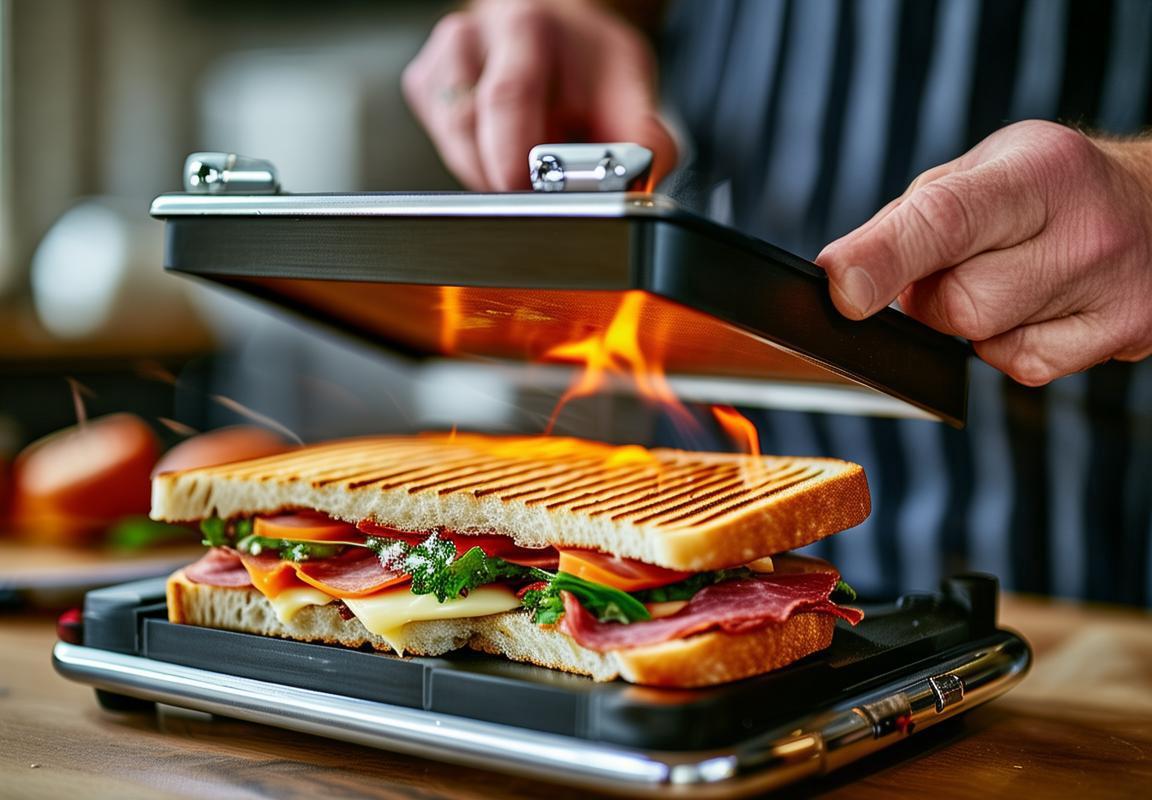
KeyFeaturesofIndustrialPaniniPresses
In the bustling kitchens of American restaurants, there’s a small yet powerful device that has become a staple: the industrial panini press. These machines are not just for creating those delightful sandwiches we all love; they are designed to withstand the demands of high-volume commercial cooking. Let’s delve into the key features that make industrial panini presses a game-changer in the American culinary landscape.
Their robust build is one of the most striking features of these presses. Crafted from durable materials like stainless steel, they are built to last and withstand the rigors of constant use in busy kitchens. This durability means that even under heavy demands, these presses maintain their performance without succumbing to wear and tear.
Precision temperature control is a critical feature that sets industrial panini presses apart. With precise temperature settings, chefs can achieve the perfect amount of toastiness, ensuring that each sandwich is cooked to the exact specifications needed for consistency and quality. This feature is especially important in fast-paced environments where speed is crucial without compromising on taste.
The non-stick surfaces on these industrial presses are another standout feature. They facilitate easy cleaning and reduce the risk of food sticking to the surface, saving valuable time during service. Chefs can spend less time on cleanup and more on preparing a variety of dishes, making these presses a time-efficient tool.
The versatility of industrial panini presses is unparalleled. They can be used to cook a wide range of items, from sandwiches and wraps to grilled vegetables and meats. This versatility is particularly beneficial in diverse restaurants where a menu might cater to various dietary preferences and restrictions.
The adjustable plates are a convenient feature that allows chefs to tailor the cooking process to different sandwich sizes. Whether it’s a small wrap or a large hoagie, the ability to adjust the plates means that the press can accommodate various shapes and sizes without compromising on the quality of the final product.
Industrial panini presses often come with an intuitive control panel. These panels are designed with ease of use in mind, allowing chefs to set and change settings quickly without needing to refer to an instruction manual. This is especially valuable in a fast-food setting where efficiency is key.
Safety features are integrated into the design of these presses to prevent accidents in the kitchen. Overheat protection, for example, automatically shuts down the device if it gets too hot, which not only prevents damage but also minimizes the risk of fire. Additionally, some models come with safety locks to prevent accidental operation when not in use.
The compact size of industrial panini presses is a significant advantage. They are designed to fit into limited kitchen spaces without taking up valuable counter real estate. This compactness is ideal for kitchens that have limited room or need to maximize their workspace.
The ability to use these presses in both countertop and undercounter settings provides flexibility in kitchen design. They can be placed on a countertop for quick access or installed under the counter for a cleaner, more streamlined look.
Finally, the consistent heat distribution across the plates is a feature that ensures even cooking throughout the sandwich. This consistency is crucial for maintaining the integrity of the ingredients and the overall quality of the dish.
In summary, the key features of industrial panini presses—robust build, precision temperature control, non-stick surfaces, versatility, adjustable plates, intuitive control panels, safety features, compact size, flexibility in placement, and consistent heat distribution—are what make them a crucial tool in American kitchens. These features not only enhance the cooking experience but also contribute to the efficiency and safety of the commercial cooking environment.
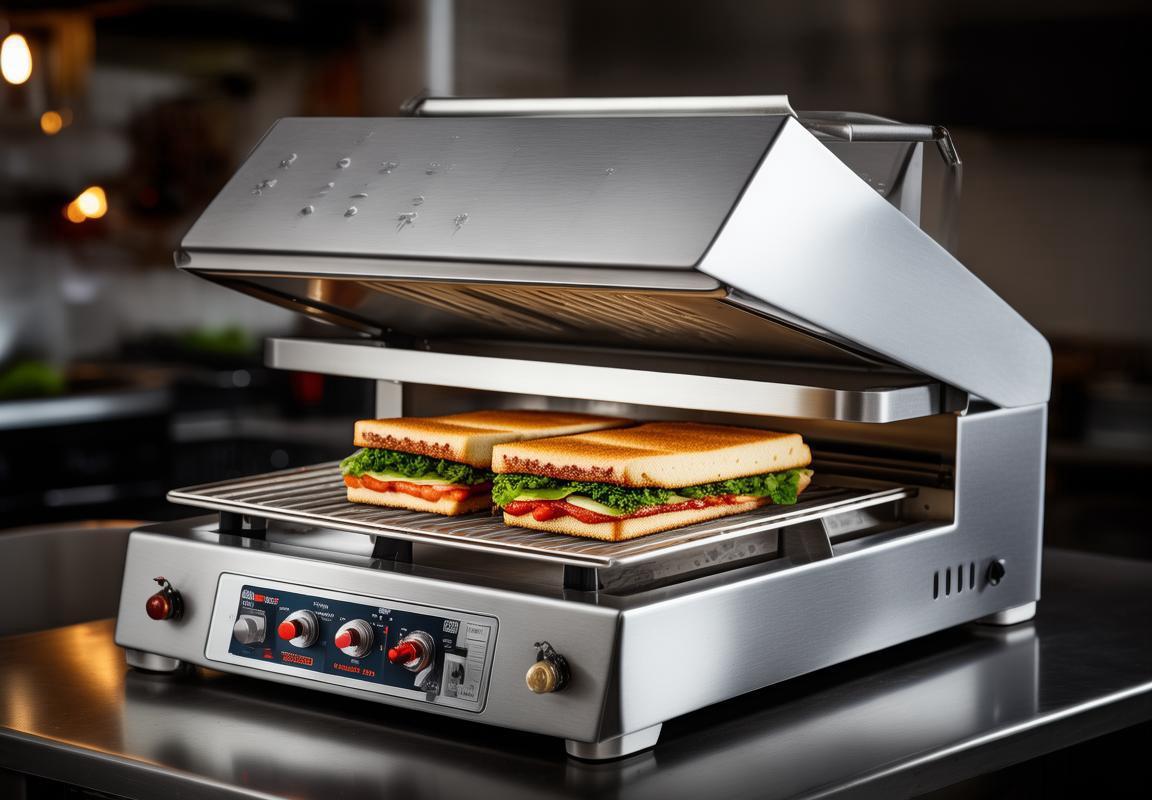
TechnologicalAdvancements
The integration of smart technology has revolutionized the way industrial panini presses operate. With features like touchscreens and programmable settings, operators can easily adjust heat levels and cooking times to perfection. This not only enhances the user experience but also ensures consistent results every time.
Automated temperature control systems have become a staple in modern industrial panini presses. These systems monitor and adjust the heat distribution throughout the cooking process, ensuring that each sandwich is cooked evenly without overcooking or burning. This level of precision is crucial in high-volume kitchens where speed and quality are paramount.
The introduction of non-stick surfaces has made cleaning and maintenance a breeze. These surfaces not only prevent food from sticking but also reduce the need for excessive oil or butter, contributing to healthier cooking practices. The ease of cleaning is a significant factor for busy kitchens looking to maintain a hygienic environment.
Safety features have been greatly improved in recent models. From automatic shut-off mechanisms to prevent overheating to cool-touch handles, these presses are designed with the operator’s safety in mind. These advancements have made industrial panini presses more reliable and user-friendly.
Incorporating modern design elements, industrial panini presses have become more aesthetically pleasing. Sleek, stainless steel exteriors and compact designs make them a stylish addition to any kitchen. The combination of functionality and design has made these presses not just a tool but a statement piece.
Energy efficiency is a growing concern in the commercial kitchen industry. Newer models of industrial panini presses are equipped with energy-saving features that reduce power consumption without compromising on performance. This not only helps businesses save on their utility bills but also contributes to a more sustainable operation.
Innovation in materials science has led to the development of high-quality, durable components. The use of robust materials ensures that these presses can withstand the rigors of a busy kitchen environment. From the hinges to the heating elements, these presses are built to last.
The inclusion of digital timers and countdown functions has added a layer of convenience. Operators can set specific cooking times for various types of sandwiches, allowing for a more streamlined workflow. This feature is particularly beneficial in fast-paced environments where efficiency is key.
The integration of Wi-Fi capabilities has opened up new possibilities. Some industrial panini presses can now be connected to kitchen management systems, allowing for remote monitoring and control. This connectivity not only improves operational efficiency but also enables predictive maintenance, reducing downtime and extending the lifespan of the equipment.
The use of LED lighting inside the press has made it easier for operators to monitor the cooking process. By illuminating the interior, these lights ensure that every detail of the sandwich is visible, leading to better control over the final product.
Finally, the customization options available for industrial panini presses have expanded. From different size configurations to adjustable pressure settings, these presses can be tailored to meet the specific needs of a wide range of establishments, from delis to stadiums. This adaptability is a testament to the versatility and evolution of the technology behind these cooking devices.
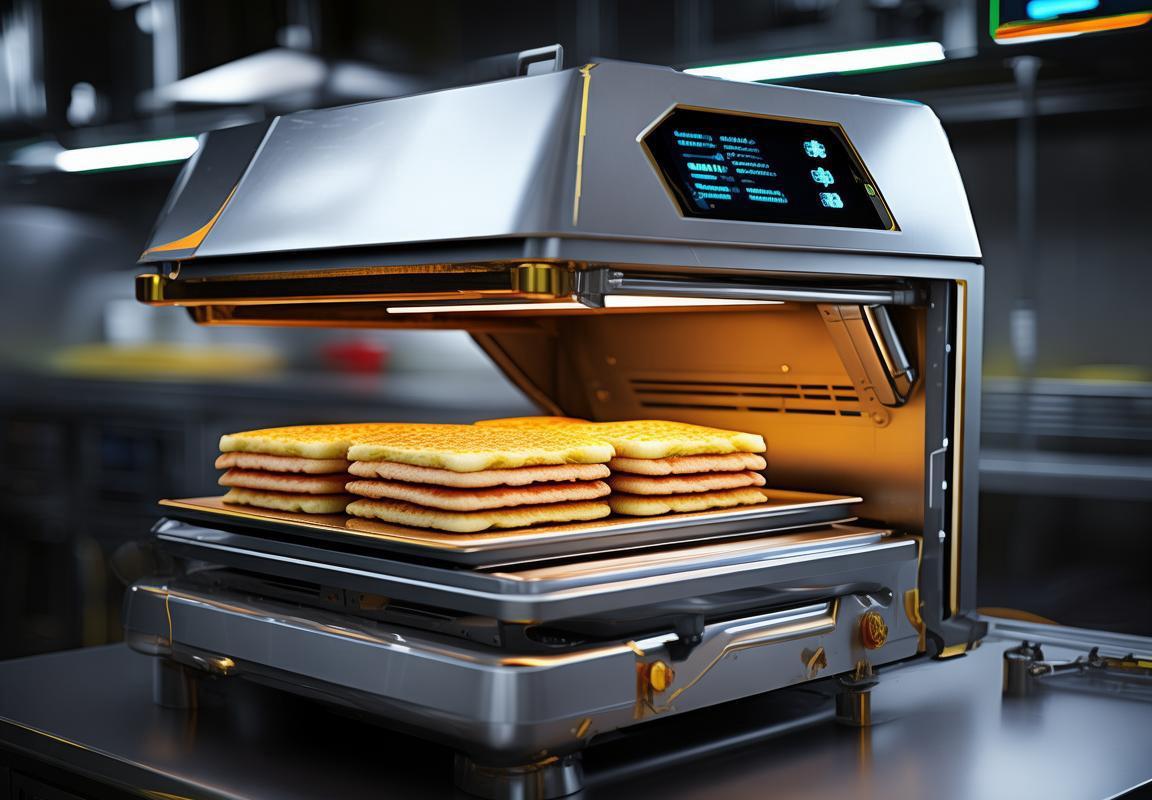
TheImpactofHealthandWellnessonSales
The surge in health and wellness trends has significantly influenced consumer preferences and, as a result, has had a profound impact on the sales of various products, including industrial panini presses. Here’s how these trends are reshaping the market:
Customers are increasingly seeking food options that align with their health goals, leading to a growing demand for healthier eating habits. This shift has prompted manufacturers of industrial panini presses to develop models that cater to these dietary preferences.
With the rise of the “clean eating” movement, there’s a notable preference for foods that are natural, unprocessed, and free from additives. This has led to an increase in the sales of panini presses that can be used to prepare fresh, homemade sandwiches, ensuring that the final product is free from the preservatives and fillers often found in pre-packaged foods.
The health and wellness sector has witnessed a surge in interest in gluten-free, vegan, and low-carb diets. Industrial panini presses have responded by offering models that can cook a variety of ingredients, from gluten-free breads to plant-based alternatives, allowing restaurants and cafes to meet the needs of these specific dietary requirements.
The convenience factor is another aspect of health and wellness that has influenced sales. Many consumers are looking for quick and easy ways to prepare nutritious meals, and industrial panini presses provide a solution. These presses can cook a sandwich in just a few minutes, making them a valuable tool for busy professionals or those looking to avoid unhealthy fast-food options.
The wellness industry also emphasizes the importance of cooking at home, where ingredients can be controlled, and the risk of contamination minimized. Industrial panini presses allow for a level of control over the cooking process that is often missing in fast-food or takeout meals, encouraging more individuals to choose homemade options.
The awareness of the benefits of whole grains has also had an impact on sales. Industrial panini presses are ideal for cooking whole-grain breads, which are rich in fiber and can contribute to a healthier lifestyle. As a result, restaurants that offer panini sandwiches made with whole-grain breads are likely to see increased sales due to the health-conscious consumer base.
The health and wellness trend has also led to a greater focus on customization. Consumers are more likely to purchase products that allow them to tailor their meals to their personal preferences. Industrial panini presses enable the creation of customized sandwiches, with a variety of fillings and toppings that can be easily adjusted to meet individual dietary needs.
The environmental impact of food production has also become a significant concern. As more consumers opt for sustainable and eco-friendly options, the demand for products that use less energy and contribute to a lower carbon footprint has grown. Industrial panini presses that are energy-efficient and have durable, recyclable materials are becoming more popular, aligning with these green living values.
Finally, the health and wellness movement has prompted the development of innovative new products. This includes panini presses with additional features like temperature control, adjustable pressure, and non-stick surfaces, which can help prevent food waste and ensure that each sandwich is cooked to perfection. These innovations are not only beneficial for the consumer but also for businesses looking to enhance their menu offerings and meet the expectations of today’s health-conscious patrons.

DistributionChannelsandRetailStrategies
In the competitive landscape of the kitchen appliances market, distribution channels and retail strategies play a pivotal role in reaching consumers and driving sales. Here’s a closer look at how these elements intertwine with the sale of industrial panini presses.
The rise of online marketplaces has revolutionized how consumers discover and purchase products. Platforms like Amazon and eBay have become go-to destinations for both small-scale and large-scale retailers, offering a wide array of industrial panini presses at varying price points. This accessibility has expanded the customer base, attracting not just local businesses but also international buyers.
Specialized retail stores have also found their niche in the market. Stores that cater to commercial kitchen equipment have started to include industrial panini presses among their offerings, recognizing the growing demand for high-quality appliances in the food service industry. These stores often provide a more personalized shopping experience, allowing customers to touch and feel the products before making a purchase.
Trade shows and industry exhibitions serve as crucial touchpoints for manufacturers and retailers to showcase their latest industrial panini presses. These events are a blend of networking, education, and product demonstration, where potential buyers can get a firsthand look at the latest features and innovations. The interactive nature of these events can lead to immediate sales and also foster long-term business relationships.
The influence of social media cannot be overstated in today’s retail landscape. Brands and retailers use platforms like Instagram, Facebook, and Twitter to create buzz around new products, share customer testimonials, and offer exclusive deals. By leveraging user-generated content, they can build trust and credibility, which can translate into increased sales.
Collaborations with influencers and chefs have become a common strategy to boost the visibility of industrial panini presses. Influencers with a strong following in the food and cooking community can create content that showcases the versatility and quality of these appliances. Chefs, on the other hand, can provide professional endorsements that resonate with culinary professionals and enthusiasts alike.
In the realm of retail strategies, loyalty programs have gained traction. By offering rewards for repeat purchases, retailers can encourage customer retention and foster a sense of community around the brand. Additionally, personalized shopping experiences, such as virtual consultations or product recommendations based on customer preferences, can enhance the shopping experience and drive sales.
The integration of e-commerce with brick-and-mortar stores has become a key strategy. Omnichannel retailing allows customers to browse products online, order them for home delivery, or even pick them up in-store. This flexibility caters to the diverse preferences of consumers and ensures that they can access the products they want, when and how they want them.
Another innovative approach is the use of augmented reality (AR) and virtual reality (VR) in the retail experience. These technologies allow customers to visualize how industrial panini presses might fit into their kitchen environments before making a purchase. This immersive experience can reduce the likelihood of returns and increase customer satisfaction.
Lastly, the importance of customer service cannot be underestimated. Providing exceptional post-sales support, including troubleshooting guides, maintenance tips, and quick response to inquiries, can create a positive brand image and encourage repeat business.
In summary, the distribution channels and retail strategies employed by manufacturers and retailers of industrial panini presses are diverse and multifaceted. From online marketplaces to social media engagement, from trade shows to loyalty programs, these strategies collectively work to ensure that the right products reach the right customers in the most effective and satisfying way possible.
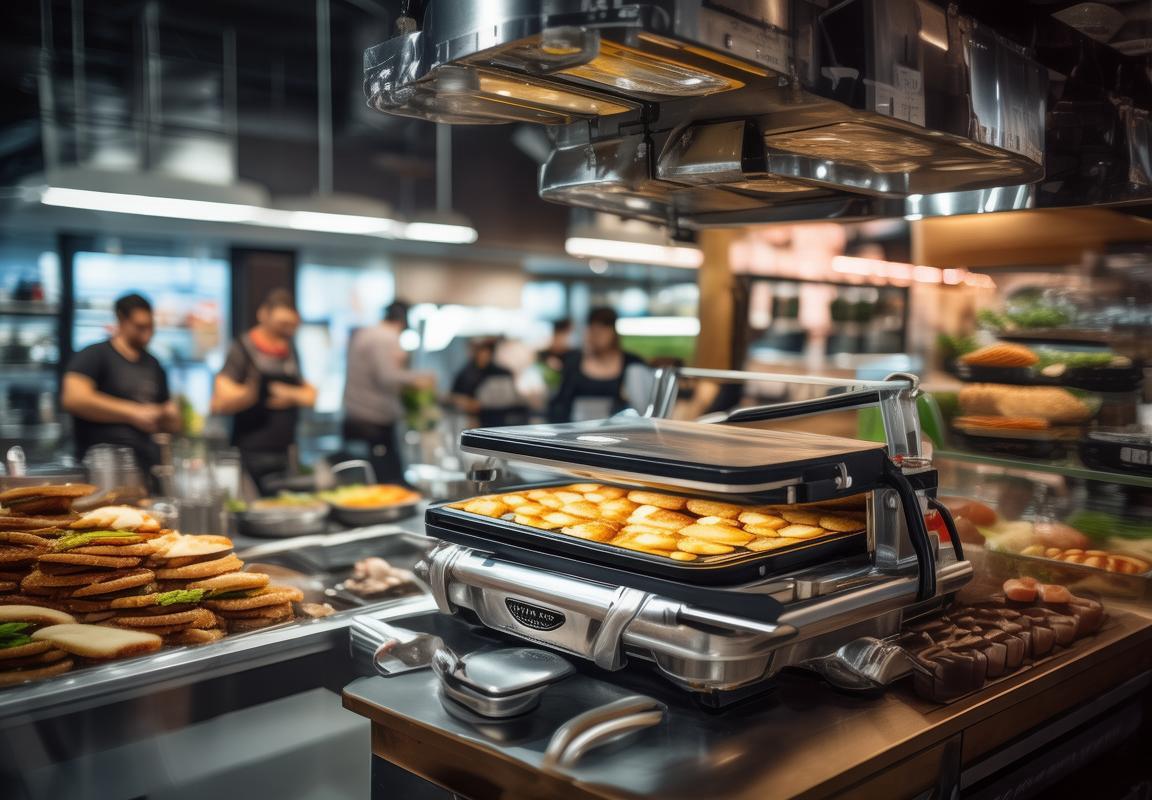
CaseStudies:SuccessfulImplementations
In the world of commercial cooking, the right equipment can make all the difference. Let’s delve into a few case studies where the strategic implementation of industrial panini presses has led to remarkable success.
The bakery “Bread and Beyond” in Munich, Germany, found that by incorporating an industrial panini press into their menu, they saw a surge in sales. The press allowed them to offer a variety of pressed sandwiches that were both visually appealing and quick to serve, catering to the busy lunchtime crowd.
At “Sunny Side Up Cafe” in Los Angeles, the introduction of an industrial panini press was a game-changer. They started offering gourmet paninis that were not only delicious but also a healthier alternative to traditional fast food. The press’s ability to cook evenly and seal in flavors was a hit with customers looking for a satisfying meal without the guilt.
The “Urban Deli” in London embraced the industrial panini press as a way to differentiate their menu from competitors. They crafted a unique range of paninis that included fusion flavors, like a Thai chicken satay or a Brazilian chorizo and avocado creation. The press’s precision and consistency in cooking these complex flavors were crucial to their success.
In a small town in Texas, “The Local Diner” faced a challenge of attracting young customers. They decided to add an industrial panini press to their kitchen, offering a variety of artisanal sandwiches. The press’s versatility allowed them to experiment with different breads and fillings, creating a menu that became a local favorite.
The “Green Grocer” in San Francisco took a different approach by using the industrial panini press to promote their organic and locally sourced ingredients. They created paninis that highlighted the freshness of their produce, turning a simple meal into an experience that resonated with health-conscious consumers.
In a coastal town in Australia, “Seaside Bites” faced the issue of slow service times during peak tourist season. By investing in an industrial panini press, they were able to serve pressed sandwiches quickly, reducing wait times and improving customer satisfaction.
The “City Bistro” in New York City used the industrial panini press to offer a unique dining experience. They paired their press with a selection of craft beers and local wines, creating a tapas-style menu that was perfect for the city’s on-the-go diners.
The “Cultural Kitchen” in Barcelona found that the industrial panini press was a perfect fit for their diverse menu. They used it to create sandwiches that reflected the flavors of different cultures, from Mediterranean to Middle Eastern, attracting a wide range of customers seeking new culinary adventures.
These case studies illustrate how the strategic implementation of industrial panini presses can lead to increased sales, improved customer satisfaction, and a unique dining experience. From busy urban cafes to quaint local diners, the press has proven to be a versatile tool for chefs and restaurateurs looking to stand out in a competitive market.

RegulatoryEnvironmentandCompliance
In the evolving landscape of the European and American markets, regulatory environments play a pivotal role in shaping the compliance landscape for industrial panini presses. From safety standards to environmental regulations, understanding these frameworks is crucial for businesses aiming to thrive in these regions.
The European Union’s stringent safety regulations have been a cornerstone for the manufacturing and distribution of industrial panini presses. Compliance with the General Product Safety Directive (GPSD) and the Machinery Directive ensures that these presses meet high safety and health standards. This not only protects consumers but also provides a competitive edge for companies that prioritize safety.
Environmental regulations are equally stringent, with the EU’s Waste Electrical and Electronic Equipment (WEEE) Directive and the Restriction of Hazardous Substances (RoHS) Directive imposing strict guidelines on the design and disposal of electronic products. Industrial panini presses, being electronic devices, must adhere to these rules, which often require manufacturers to invest in sustainable materials and recycling processes.
In the United States, the Federal Communications Commission (FCC) and the Occupational Safety and Health Administration (OSHA) set the stage for compliance. The FCC’s regulations ensure that industrial panini presses do not interfere with other electronic devices, while OSHA standards protect workers from potential hazards associated with the use of these presses.
The American market also grapples with state-specific regulations, which can vary widely. For instance, California’s Proposition 65 requires manufacturers to warn consumers about potential exposure to chemicals known to cause cancer or reproductive toxicity. This adds another layer of complexity for companies looking to expand their presence in the U.S.
Navigating these regulations often requires a dedicated compliance team or the hiring of consultants who specialize in regulatory affairs. Companies must stay abreast of changes in legislation, as updates can occur frequently and have significant implications for product design, labeling, and marketing.
In addition to safety and environmental regulations, intellectual property laws also play a role in the compliance landscape. Patents, trademarks, and copyrights protect the innovations and branding of industrial panini presses, ensuring that companies can differentiate their products in a competitive market.
For companies looking to enter new markets, understanding the local regulatory environment is paramount. This includes not only the laws and standards but also the enforcement mechanisms in place. For instance, the EU’s Rapid Alert System for Non-Food Products (RAPEX) allows for the rapid exchange of information on unsafe products, which can impact a company’s reputation and bottom line if not managed effectively.
Compliance with regulatory requirements is not just about avoiding fines or legal action; it’s also about building trust with customers and partners. A reputation for compliance can be a significant asset, especially in industries where safety and quality are paramount.
Moreover, regulatory compliance can also lead to cost savings in the long run. By designing products that meet all necessary standards from the outset, companies can avoid costly redesigns and recalls later on. It also opens up opportunities for certification programs that can enhance a company’s marketability.
In conclusion, the regulatory environment and compliance are integral to the success of industrial panini presses in both Europe and America. Staying informed, proactive, and compliant with these laws is not just a legal requirement but a strategic move that can lead to sustainable growth and a strong market position.
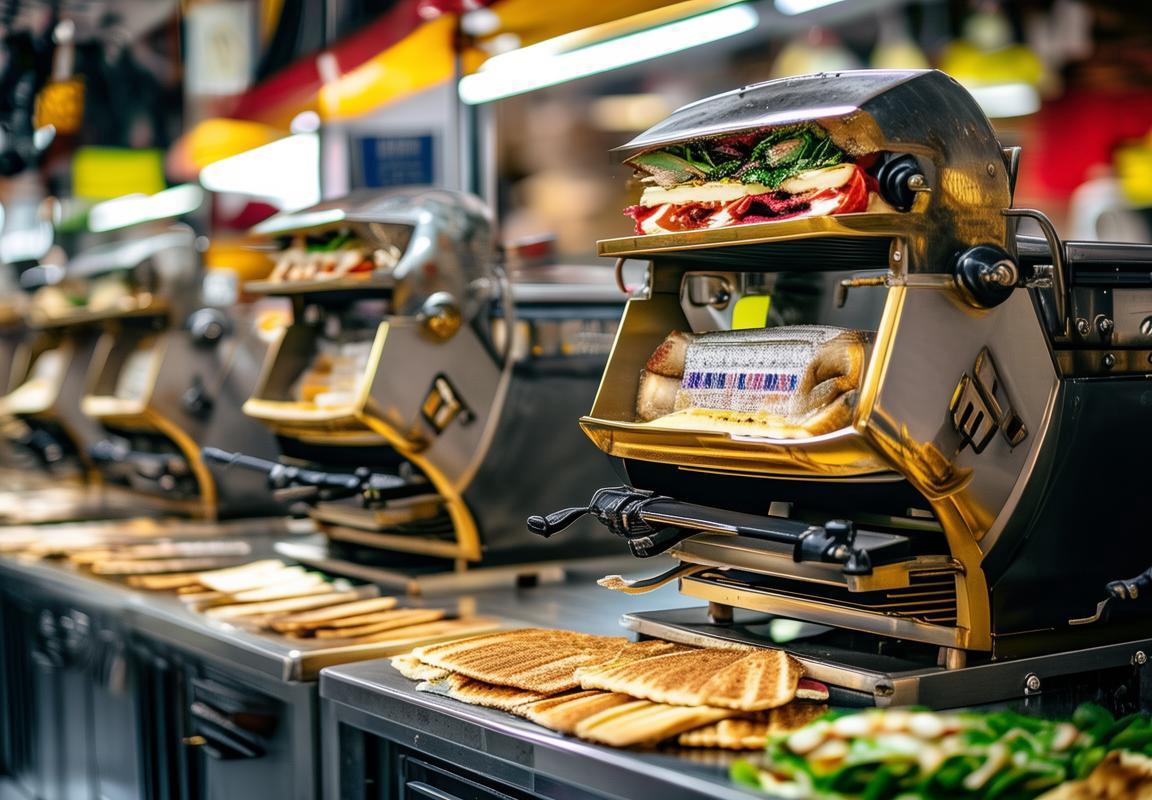
FutureOutlook:PredictionsandChallenges
The landscape of the culinary industry is constantly evolving, and with it, the expectations and demands of consumers. As we look ahead, several key trends are shaping the future of the industry, offering both opportunities and challenges.
Technology integration is set to become more profound, with advancements in automation and precision cooking. Smart kitchen appliances will likely become more prevalent, allowing for greater efficiency and customization in food preparation. The ability to tailor recipes and cooking times based on individual preferences and dietary restrictions is an area that could see significant growth.
Sustainability remains a pivotal concern. The industry will need to find ways to reduce its environmental footprint, from sourcing ingredients to waste management. This could mean investing in more sustainable packaging, exploring alternative energy sources, and adopting more eco-friendly production methods.
Globalization will continue to influence the culinary world, with international flavors and cooking techniques becoming more accessible and popular. Cross-cultural dining experiences will likely become more common, blurring the lines between traditional cuisines and fostering a more diverse culinary landscape.
Health and wellness trends are expected to persist and even intensify. Consumers are increasingly conscious of what they’re putting into their bodies, seeking out organic, locally sourced, and low-inflammatory foods. This shift will push the industry to innovate in health-conscious food options and to cater to dietary preferences such as veganism, vegetarianism, and gluten-free diets.
E-commerce is reshaping how consumers interact with food products. Online food delivery services and subscription boxes are becoming more sophisticated, offering a wider variety of products and services. This trend is likely to continue, with more businesses exploring direct-to-consumer models and leveraging digital platforms to reach customers.
The rise of plant-based alternatives is a phenomenon that’s not going away. As concerns about the environment and animal welfare grow, more consumers are turning to meatless options. This trend is prompting the development of increasingly realistic and tasty plant-based proteins, which could revolutionize the food industry.
Food safety will remain a top priority. With the rise of foodborne illnesses and the increasing complexity of global supply chains, there will be a greater emphasis on ensuring the safety and quality of food products. This may involve stricter regulations and more rigorous testing procedures.
Innovation in food technology, including 3D printing and precision fermentation, could transform how we produce and consume food. These technologies have the potential to address issues like food scarcity, food waste, and personalized nutrition.
The industry will also need to adapt to the changing demographics. As the population ages, there will be a growing demand for food that is not only nutritious but also easy to prepare and digest. Similarly, as the millennial generation becomes a larger segment of the consumer base, there will be a shift towards convenience and on-the-go options.
The challenge of keeping up with these trends will be significant. Businesses will need to invest in research and development, training, and infrastructure to stay competitive. They’ll also need to be agile, ready to pivot their strategies in response to shifts in consumer behavior and market dynamics.
Lastly, the industry will face the challenge of addressing social and economic disparities. As the cost of living increases, access to healthy and affordable food becomes more critical. There’s a need for solutions that can provide nutritious meals to those in underserved communities without compromising on quality or taste.